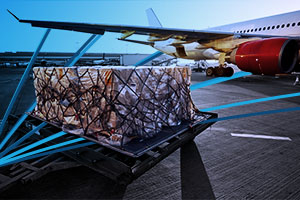
Transpacific Air and Ocean Shipping Space Is Already Tight | Transportfolio
If you’ve heard the term “perfect storm” applied more to transportation lately than you have since the book by Sebastian Junger came out in 1997, you’re not alone. Unfortunately, it’s the best way to describe what is happening right now in the air and ocean freight markets. Peak shipping season has heated up early. The perfect storm is upon us. Rates are up on the spot market, and air and ocean space are hard to find. We recommend you take action now to ensure your holiday shipments are covered.
Peak seasons happen at various times throughout the year. A predictable pattern of events follows: shipping volumes spike, space on airlines and vessels becomes harder to secure, and prices go up.
The holiday peak season is one of the busiest shipping periods of the year around the world. Usually, this is roughly how a typical busy season goes:
| Air freight | |
| August-September | Shoulder season; shipping ramps up |
| October-November | Peak shipping season |
| November-December | Shoulder season; shipping demand begins to taper off |
| Ocean freight | |
| June/July | Shipping volumes start increasing |
| August/September | Peak shipping season |
This year is different. Ocean volumes gathered momentum starting the last week in June, and air freight volumes started increasing in mid-July. The situation is especially serious in the Transpacific (Asia-North America) lane because of the sheer volumes that are moving.
Some wonder if the threat of tariffs is behind this early spike in peak shipping. Although the first set of tariffs did not make a huge impact, the new impending tariffs could impact close to 50% of the containerized imports into the U.S. And, certainly, some shippers have already started repositioning their inventory in case the tariffs actually happen. But a combination of forces was already at work in the market, even before the threat of tariffs arose.
What it looks like now in Transpacific air freight
Since July, air freight pricing has increased between China and the United States. Load factors—the amount of air cargo space that is already being used—run in the middle- to high-90% range at present, an indicator that space is already tight. Ocean vessels are overbooked, for reasons we will explore below, so shippers are coming to us to convert required shipments to air. China’s ecommerce boom adds extra air volumes to the amount of freight that typically moves this time of the year.
There are other complicating factors. Nippon Cargo Airlines is a significant carrier on the Transpacific Eastbound, and questions surfaced earlier this year about its plane maintenance. In an abundance of caution, Nippon Cargo Airlines grounded their entire fleet on June 17 until they can verify that all maintenance records are accurate and complete. Two months later, only a handful of their aircraft have returned to service. At this time, all indications are that the remainder of their fleet will be slow to come back into operation. This has reduced capacity dramatically in the Transpacific.
To sum it up, high load factors and reduced air freight capacity are driving air rates up. While we can still find space for customers, it becomes more challenging each week. We’ve seen airlines add charters for the upcoming peak season as the tightening of capacity has become more apparent, but the added space was quickly snapped up by the market at premium prices.
In addition, facilities in the U.S. and the agents assigned to handle these inbound flights are struggling to keep up with demand. Once the cargo has arrived, it can be an excruciatingly painful process to recover the freight if your service provider doesn’t have strong relationships and the proper procedures in place.
What’s happening now in Transpacific ocean freight?
For the 2018-19 season, carriers and their alliances began to roll out additional capacity to the marketplace and announced new improvements to their service offerings. About 1.2 million TEUs were to be injected into the global marketplace. Most of the new capacity had been expected earlier, but the carriers postponed additions of the capacity year after year until demand was healthy enough, and in 2017, demand did start to improve.
Most of the larger 14,000 TEU to 22,000 TEU vessels went into the Asia Europe/Mediterranean trade lanes. This had a cascading effect, sending the smaller 8,000 to 14,000 TEU vessels into other trade lanes, including Transpacific Eastbound (TPEB). Thus, carriers injected about 8% additional capacity into the TPEB trade lane, while demand was projected to be around 4% to 5%. For the first 6 months of this year, carrier demand was around 2% to 4%, and with the additional capacity, the spot rates were down when compared to the same time period in previous years. Carriers were also not successful in getting the annual contract rates up to the healthier levels they needed. Since fuel costs were also 40% to 50% higher than the year before, and with charter rates at the highest levels seen in years, carrier costs were up in the first 6 months while revenue was down. The carriers did try to implement emergency bunker surcharges and other operational recovery surcharges to bring rates up to healthier levels, but they were not successful in doing so across the board.
So, for the second half of 2018, carriers have begun to pull capacity on the TPEB in order to control capacity and bring up spot rates to levels that will recoup losses from the first 6 months. To this end, 7% of the capacity has been pulled from U.S. West Coast and Canada West Coast routings, and 1.5% will be removed in September on the U.S. East Coast routings.
With the impending tariffs poised to affect half of containerized imports, some importers have begun to ship earlier and at higher volumes than planned before. The Ocean markets started heating up in the third or fourth week of June, volumes steadily rose week after week, and we suspect that peak season will continue until the first week of October, which is Golden Week in China. Roll pools continue to grow at origin ports, and space is now at a premium. Some carriers are looking at potential sweeper vessels to clear out backlogs in Asia ports.
As The Journal of Commerce (JOC) pointed out recently, carriers are holding the line on weekly minimum quantity commitments (MQC). It is common during tight capacity markets for carriers to limit shippers with contracts to only one week’s worth of their total annual MQC. If the shipper has an annual commitment of 1,000 forty-foot equivalent units (FEUs), they can only use 1/50 of that, or 20 FEU, per week, and must pay the higher spot market rate for any space they need beyond that.
Preparing for peak season
As space will be at a premium, forecasting and identifying your options will be key to making it through peak season. Give your service provider a clean forecast and 14 to 21 days of lead time to make bookings at origins to support the process, but realize that this alone will not guarantee you space.
In terms of options, ensure you have procured enough capacity with your service provider(s), and that if you have been showing up with your cargo each week, as per your MQC, that you will continue to be protected on your MQC.
Finally, ensure that your service provider(s) are well diversified, in terms of the carriers and space they procure in the marketplace. This can provide you with multiple carrier options; on all alliances; on all routings; on most, if not all, service string offerings; and on premium services, which some carriers offer; as well as on any special product offerings that may be available during peak months. Contact an expert if you have any questions about preparing for the spike in air freight and ocean freight this holiday season.



